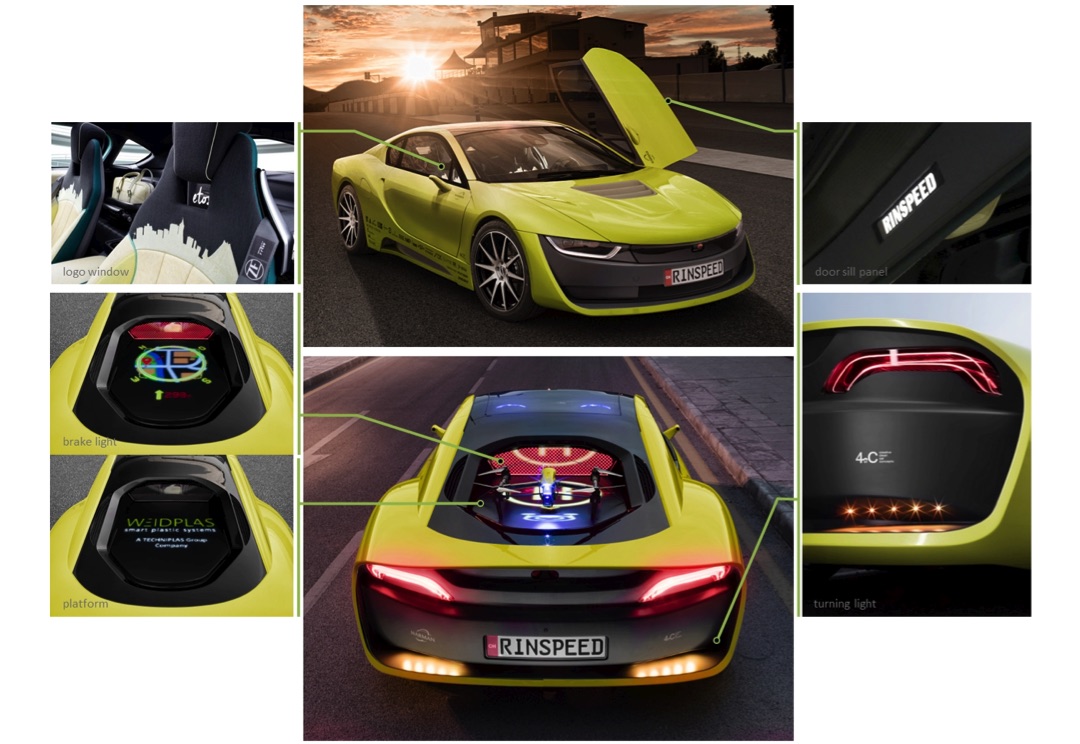
The 22th concept car from Rinspeed is celebrating its world premiere in 2016 for the first time at CES (Consumer Electronics Show) in Las Vegas and will be presented for the European market, as usual, at it’s Swiss home country during the Geneva Motor Show.
As in previous years, WEIDPLAS is using this innovative technology platform to show some eye-catching details. Visions are mixed with very near-series applications – the result is a concept car that already got some interest in the media.
The door sill panel – conventionally at the bottom of the door frame – has been relocated into the door as an illuminated RINSPEED logo which will swivel towards the pilot and also light up the immediate vicinity of the door at night.
Looking into the vehicle will reveal more ambient lighting integrated in the seat. The vehicle pulses in expectation of its driver, promising an emotional experience. A micro structured light guide pulses the etos logo, brightly materializing apparently in the dark between seat and headrest only to fade again.
At the lower rear end of the car are special turning lights. Hidden laser LEDs will project light effects on vehicle surfaces and moving light effects will create additional attention. Unexpected at first glance, yet intuitively understandable, this feature could enhance safe driving in traffic without spoiling the design of the vehicle with visible indicator lights.
The rear window will normally be transparent, except during braking, when it will assume the function of a 3rd brake light, generating a striking pattern over its entire surface to warn the traffic behind.
The most striking WEIDPLAS-feature of etos you will find at its rear end – a matt glass surface which inconspicuously blends into the overall design as an integrated component – until switched on. A LED matrix hidden under the surface of the glass may welcome the driver by means of personalized graphic designs. The flight status of the drone will be communicated as it takes off or touches down and the current duties of your flying assistant will be graphically displayed. Should you pay a visit to the racetrack, the LED matrix will perform as your stopwatch and league table comparing autonomous and manual lap times.
Beside the LED-matrix at the platform and laser-LEDs at the rear turning lights we used our OPTIBACK simulation software and micro-structuring to create special lighting effects in seats, doors and the rear window.
The OPTIBACK software will precisely define the scattering or emission characteristics of a microstructure point, based on its geometric form and size. Depending on application, light scattering elements sized 12 μm to 50 μm may be deployed. Using microstructures has the advantage that no additional materials for diffuse filtering will be required. A further major advantage is the negligible shading effect of the individual scattering points in the optical medium, thereby allowing the use of either very long or very thin optical conductors (d < 1 mm). The OPTIBACK software, developed specifically for this purpose, will use the specified distribution of light intensity and the characteristics of the materials used to calculate the distribution of these structural points in the optic fiber in order to create either homogeneously lit surfaces or specific inhomogeneous light imagery such as partial illumination, symbols that will be invisible unless lit or precisely graded light intensity.
Visit http://etos.rinspeed.eu for more information, pictures and videos about this project.

